I remember a long time ago, while traveling through China, where I saw a guy with a garbage bag full of disposable plastic water bottles, refilling them from a bathroom sink. So not only does bottled water come with a 280,000% markup, but sometimes it’s not even good.
And if you thought this was something that happens just in sketchy bus stations in China, you’d be wrong. About 25% of bottled water in the US is just tap water. Sometimes filtered, sometimes not.
As someone who enjoys budget travel to out-of-the-way destinations, I’ve spent the last several years keeping an eye on simple, portable, reliable water filters, preferably contained entirely within a bottle, that can handle the sorts of contaminants commonly found in chemically-flavored tap water, bacteria-filled mountain streams, and virus-hiding third world village wells. The number of convenient options that can handle all three of these challenges is, like…five or six. In the world.
So that’s why I was so glad to see a new one show up on the scene a few years ago, which can handle all of those challenges just fine, without requiring any awkward hoses, breakable mechanical pumps, slow-flow straw sucking, or any other nuisance like that. It’s called the Grayl, and it works just like a French press. Fill it up, press the filter, and drink. That’s it.
When I reviewed the original version of the Grayl, I mentioned that its filtration capabilities were as good as anything you can find, with a cost-effectiveness on par with industry heavyweights that have been around for years, and a simplicity (and elegance) that you’re not likely to see anywhere else. The only potential issue, especially for lightweight backpacking, was that it was pretty heavy, coming it at about 20.75 ounces.
Enter the Grayl Ultralight, the update that solves the only real problem the original ever had. It offers the same great filtration performance, using BPA-free plastic to bring the weight down to 10.9 ounces. It feels like a totally different product now. Grayl gave me a couple test samples and spare filters, and, given how it’s currently doing on Kickstarter, there are a lot of people just as happy with it as I am.
If you’re familiar with the original, you already know how it works, as they function identically. But if you’re new to the scene, all that info is in here too.
The Grayl Ultralight, in review
Here it is:
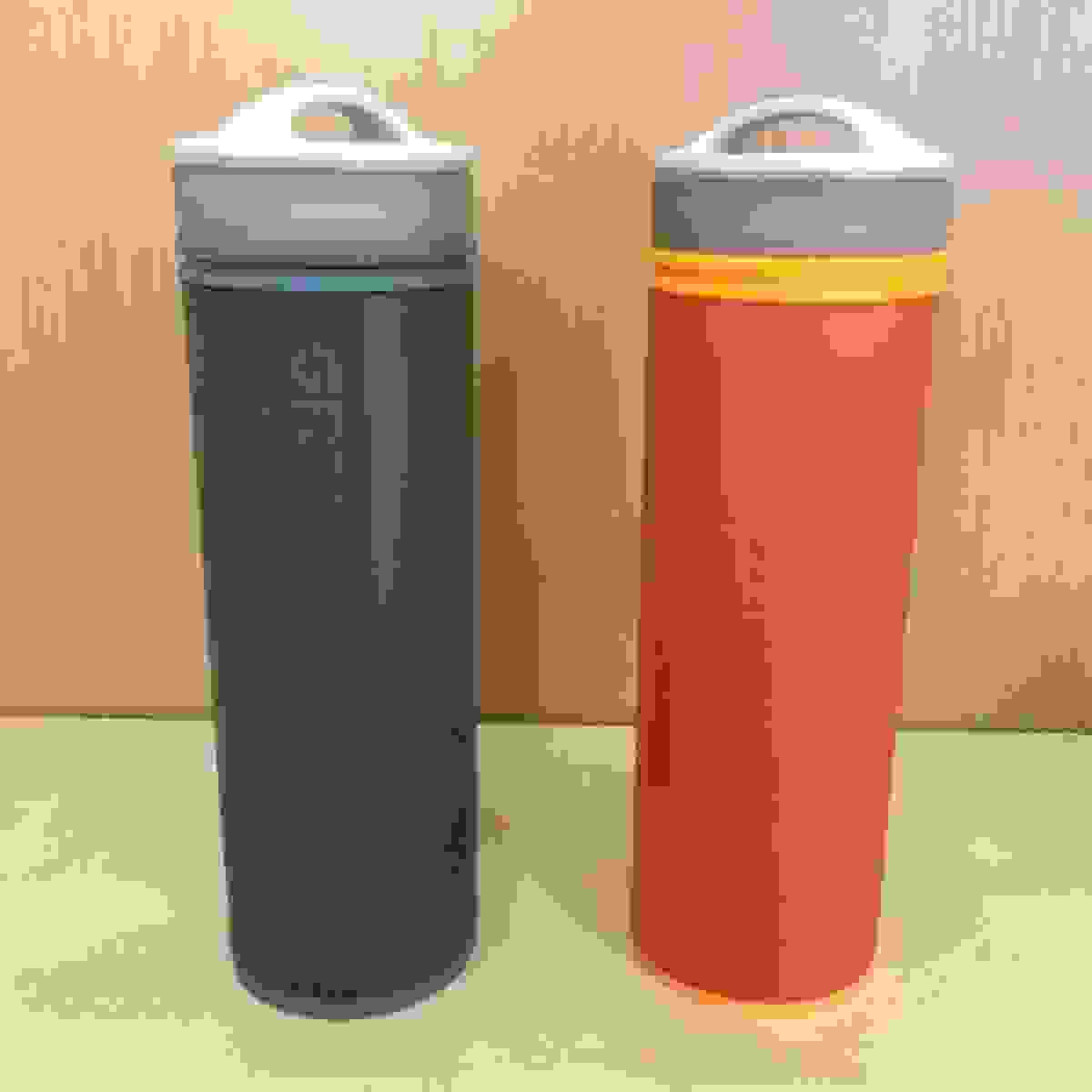
Stats
- Height: 9.625″ (24.5 cm)
- Width: 2.875″ (7.3 cm)
- Weight (empty): 10.9 oz (309 g)
- Weight (full): 30 oz (850 g)
- Capacity: 16 oz (0.473 L)
- Filter lifespan: 300 uses (40 gallons/150 L)
- Estimated Retail Price: $60 (includes one top-of-the-line Travel filter)
The big story here is the weight, which is about half as much as the original stainless steel version. For reference, a stainless steel Klean Kanteen of similar capacity is about 6 ounces (170 g), so the difference between having a filter and not having a filter is a mere 5 ounces. That’s about the weight of an average men’s t-shirt.
But as an added bonus, it’s also estimated that it’s going to retail for $30 less than the original stainless steel Grayl (now called the Legend), and $20 less than the hybrid steel/plastic version (known as the Quest). For lightweight backpackers on a budget, this is a win-win.
Filtration performance
I’m going to segue into a minor lesson on filtration and general water-related safety for a moment. The way I look at it, there are three broad categories you need to worry about when it comes to water quality:
- Particles, whether it’s dirt, dust, or sediment, but also heavy metals and chemicals, like lead, arsenic, chlorine, and many others. These can be found in ordinary tap water, and certain rivers, or lakes, and so on. Most carbon filters can handle this, and it’ll also make the water taste nice and clean.
- Bacteria, like E. Coli and Salmonella, but also bacterially-sized things, like protozoan cysts, such as giardia and cryptosporidium. I group these together, because if a filter can handle bacteria, it can handle the others. You’ll need something that can handle this category (and most likely the previous one) if you’re hiking or otherwise enjoying the great outdoors.
- Viruses, which is where many filters fall short. They’re significantly smaller than bacteria, which means you need a much better filter to handle them. Oh, and when people say their filter can remove viruses, you want actual numbers. If someone says “hey, we remove viruses!” but don’t say how many, that’s probably a bad sign. You won’t run into viruses if you’re just hiking around in a modern country, but if you’re heading someplace like rural Africa or the Amazonian jungle, you’ll want something that can handle this category (and the previous two).
Conveniently, Grayl’s filters come in exactly these options:
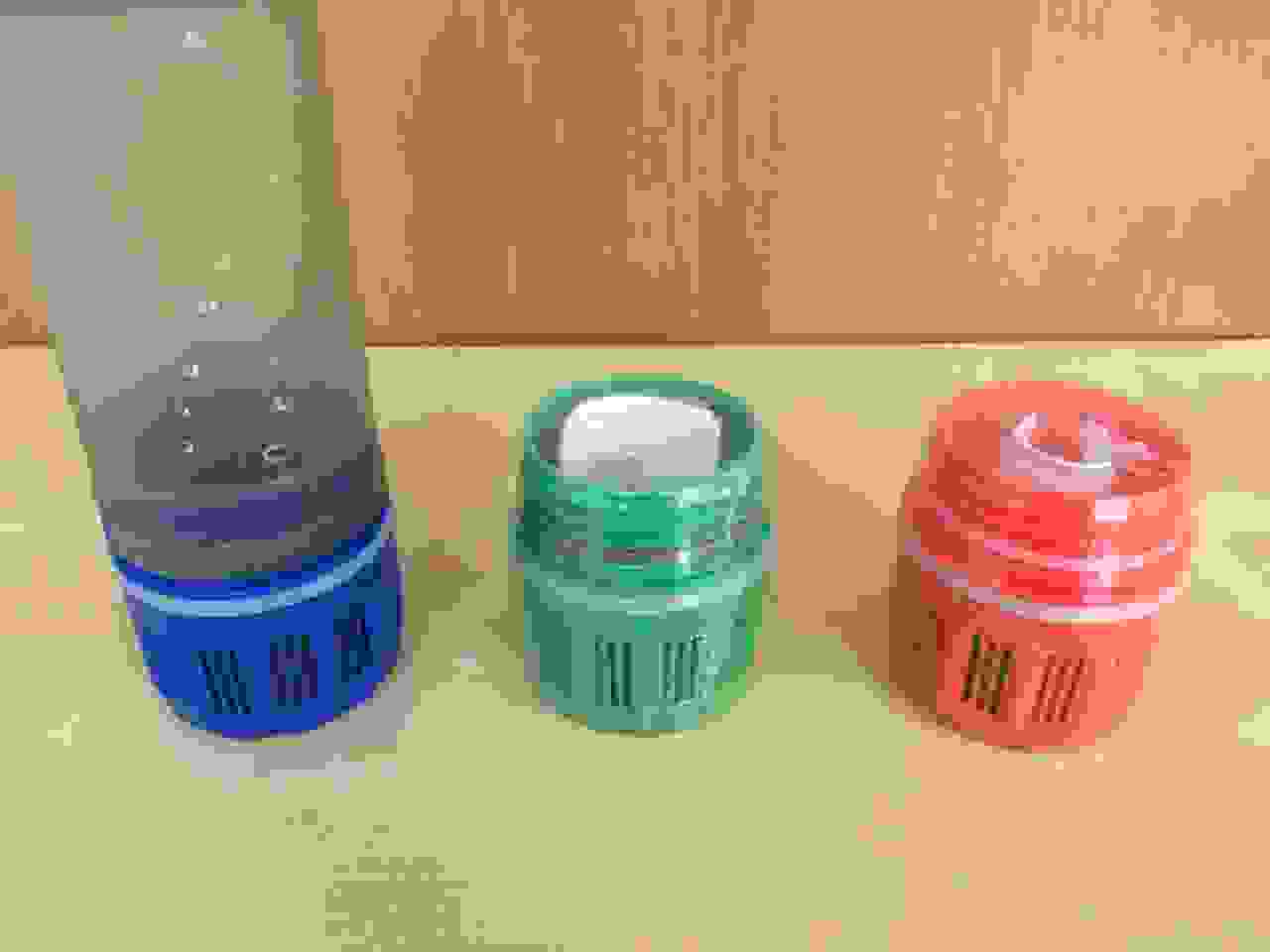
From left to right, those are the Tap, Trail, and Travel filters, conveniently named for exactly what they can handle. The Tap filter is for filtering water at home (filtering particles); the Trail filter is for outdoor hiking (filtering particles and bacteria); and the top-of-the-line Travel filter is for international travel (filtering particles, bacteria, and viruses), or for any seriously questionable water source.
This allows you to use only the filter you need, such as using the Tap filter at home, and swap it out for a Travel filter when you’re heading off to the Sahara or someplace like that. Each filter lasts 300 uses, or 40 gallons (150 L), and will slow down when it’s time to replace it.
Update: Grayl has streamlined the replacement filter options, and now offers either the Tap filter or the top-of-the-line Travel filter (which has been renamed the Purifier). A lot of customers were asking which filter was appropriate for which situation, and this way they don’t have to worry. Use the tap filter at home, and the purifier for everywhere else. As an added bonus, they’ve dropped the Purifier price from $40 to $25.
Here’s the performance of each:
Tap filter ($15) removes:
- Chemicals and metals, such as chlorine, iodine, lead, arsenic, and others. Also improves flavor and odor.
Trail filter (discontinued) removes:
- Chemicals and metals, such as chlorine, iodine, lead, arsenic, and others. Also improves flavor and odor.
- 99.99% of bacteria
- 99.94% of protozoan cysts
Travel filter ($25) removes:
- Chemicals and metals, such as chlorine, iodine, lead, arsenic, and others. Also improves flavor and odor.
- 99.9999% of bacteria
- 99.999% of protozoan cysts
- 99.9999% of viruses
Yes, count up those 9s on the end. I am not aware of any filter that matches this level of performance (most of them don’t bother filtering viruses at all), and even fewer that also offer the convenience of a bottle, which, if you haven’t tried it, is the only way to go.
Using the Grayl
Nothing says “elegant simplicity” like a minimum of components.
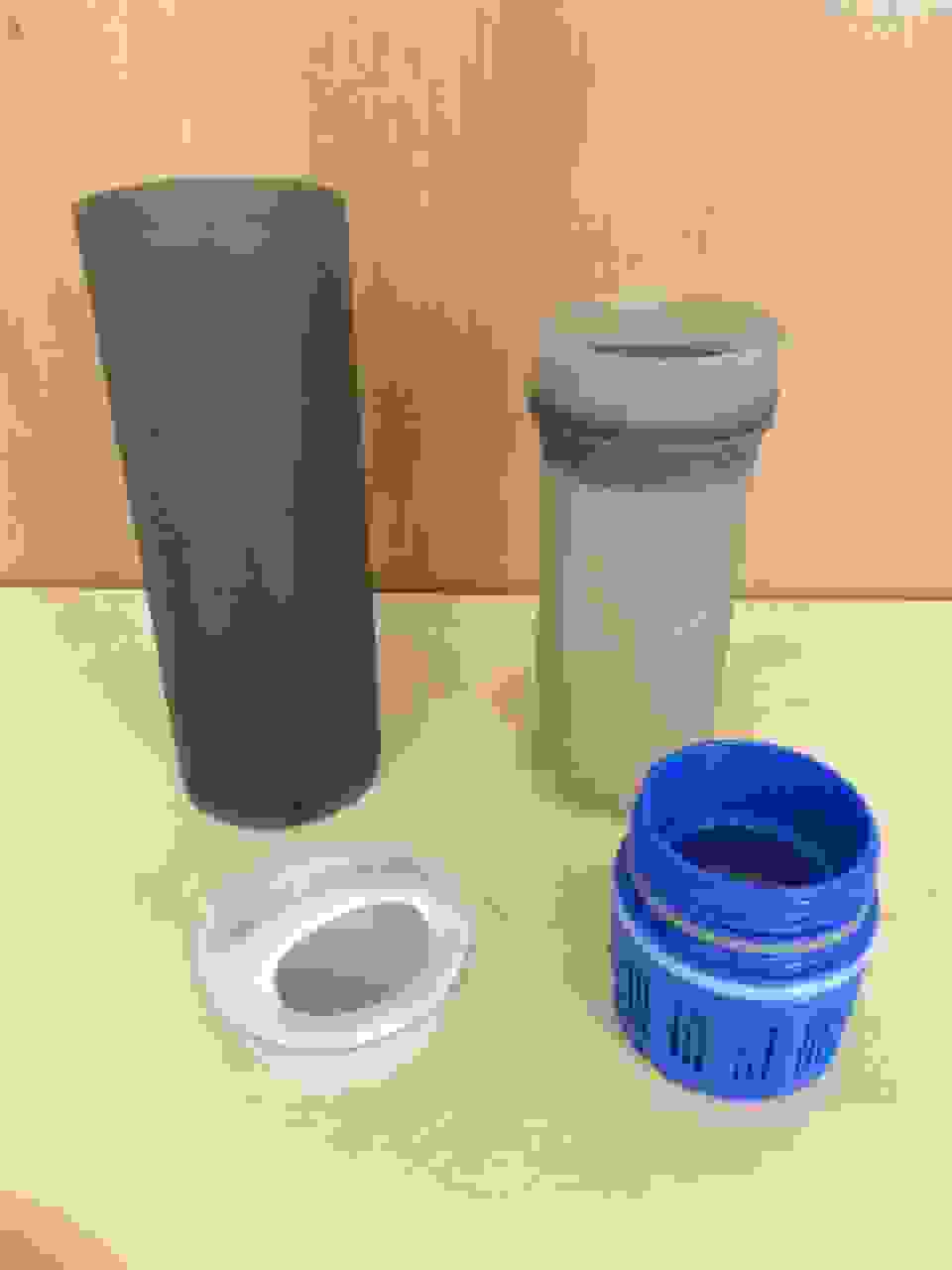
Just fill it up:
Press:
And drink:
It’s really just that simple. There’s no pump to break; no batteries can run out; no iodine to ruin the taste; no hose to uncoil and put away afterwards; no bag to hang up on a branch; no bulb to replace; no straw to hold onto the grime that gets stuck inside…no nothing. Just a few simple components that are easy to use, easy to disassemble, and easy to clean.
The only alternatives that can remotely match this ease of use are the soft-sided bottled filters that use a straw, and you suck the water through the straw while squeezing the bottle to get the water through the filter. It works, but the flow rate is pretty slow, which is agonizing when you’re trying to rehydrate on a hot day. And sometimes those bottles inexplicably use stainless steel, so you can’t squeeze the bottle to increase the flow rate. All you can do is suck. And that really sucks.
Since the Grayl presses the water through the filter all at once, you don’t have to deal with any of that, so drinking from it is just as easy as drinking a glass of water. It does take some extra effort ahead of time, since you have to press the water through the filter (it’s good to press against a low coffee table, or kneel down and press it against the ground, so you can use your body weight to make it easier), but the 15-30 seconds it takes to press the Travel filter means no sucking and squeezing later, and the Tap and Trail filters go even faster.
You know what else is great? You can pour the clean water into another container.
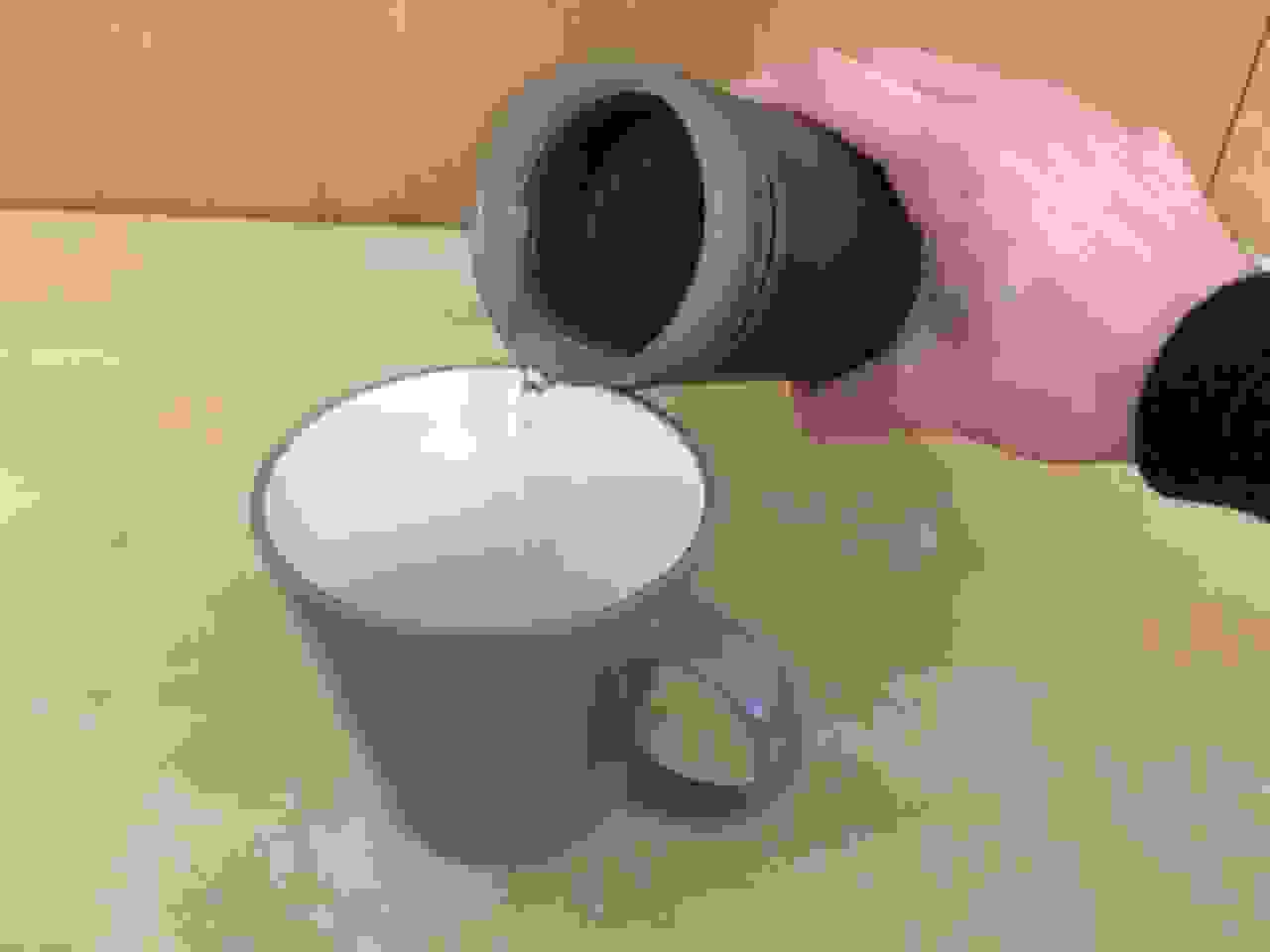
That’s generally out of the question for the suck/squeeze bottled filters, which means you can share a single Grayl between multiple people, or use it to fill extra bottles for backup. You could do the same thing with pump/hose filters, but the Grayl Ultralight is lighter, simpler, and has a lower upfront cost.
Minor improvements to this version
Compared to the original stainless steel Grayl Legend, the Ultralight has a couple design changes that fix minor usage issues.
1) Straighter
Notice how the stainless steel version can tilt a bit as you close it, whereas the Ultralight stands up straighter:
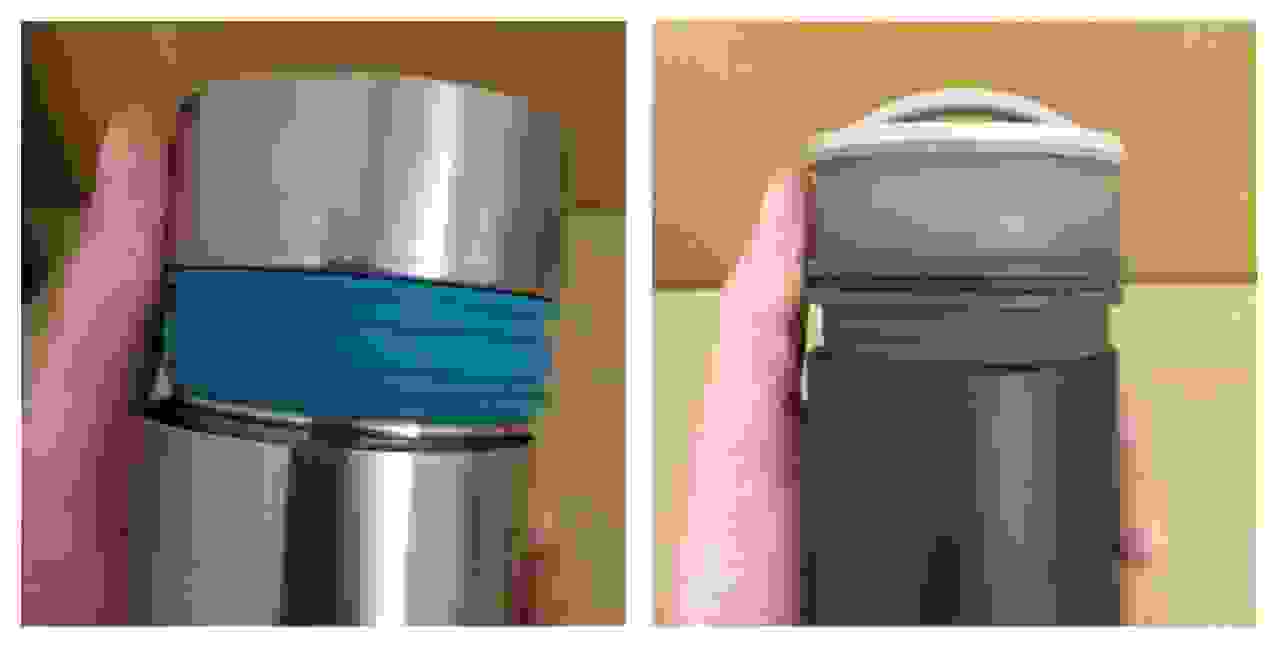
With the stainless version, it’s possible for the lower cup to “bite” into that blueish rubbery band, whereas the Ultralight won’t do that. This is partly due to the extra thickness of the plastic, which keeps it much straighter, plus that 90 degree angle where the outer cup meets the seal. There’s nothing to get in the way.
2) Grippier
That rubbery band is also bigger than before, jutting outward just a bit, rather than being recessed slightly, providing a non-slip grip for your thumb and forefinger. The plastic used in the bottle is also a bit textured, so it’s fairly grippy as well, and the textured surface also cuts down on condensation building up and dripping down the sides if the water inside is too cold.
3) Clippier
Lastly, the new lid can hook into a carabiner:
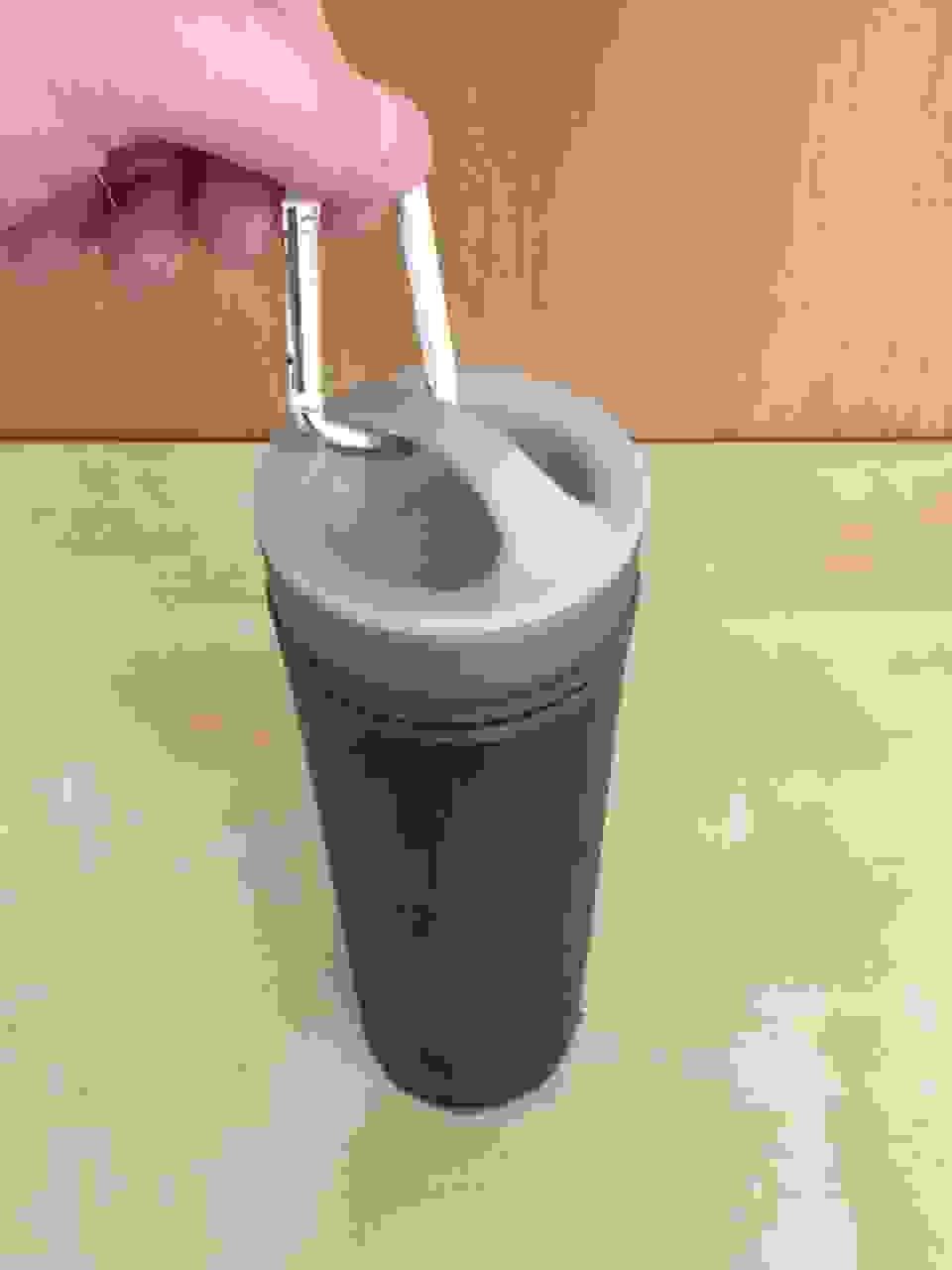
This is great for clipping it onto the side of a backpack, usually through the compression strap that tends to be over there, or you could loop a shoulder strap through it and carry it by itself, without needing a daypack.
There’s some discussion of maybe designing an alternate cap with a smaller drink spout, which would make it easier to drink while moving on a shaky bus, or riding a bike. I’m looking forward to seeing something like that at some point, but in the meantime, this is quite simple, lightweight, and carabiner-compatible. It also doesn’t take that many rotations to open it. You know how you have to rotate certain caps three or four whole times to get them open? This one doesn’t need more than a quick twist.
Minor usage tips
- You’ll want to use your body weight when you’re pressing the filter, especially when using the top-of-the-line Travel filter, which has more resistance than the other filter options. As mentioned, find a low coffee table, or a sturdy chair, or just kneel down and press against the ground, rather than using a high countertop.
- When pressing the filter, or removing the inner cup from the outer cup to fill it up again, open the lid just a bit. This will let the air escape, so you’re not fighting against a vacuum.
- When you’re pressing the filter, leave the cap on, but open slightly, so you don’t get your hands on the rim where your lips will go.
- If you take it on a plane, the air inside the bottle will be under a higher pressure than the air inside the cabin, which can force the seal open. So when you get up into the air, just open the lid, and close it again. That’ll equalize the pressure. You can also empty it out before you fly, so there’s no water to leak out (remove the inner cup from the outer cup and empty both, as there’ll be a bit of moisture in the pre-filter area as well), or, alternatively, you can fill it up all the way, so there’s little or no air inside that can change pressure. Fun physics fact: Liquids don’t change much in response to pressure.
- When you’re removing the inner cup from the outer cup, twist it a bit, instead of just pulling it straight out. It’ll come out more easier.
Final thoughts!
As you can tell, I’m quite happy with this. The one and only potential problem with the original design was the weight, which has been completely solved. The filtration performance is up there with the best filters you can possibly find, and even beats several of the more famous options out there, often by a lot. Better yet, this fits into a bottle you can take with you anywhere, with no dangly hoses, no pumping, no sucking, no squeezing, no lightbulb shining, no battery switching, no waiting half an hour for iodine tablets to work, and no iodine flavor when you’re done waiting. Just fill, press, and drink.
In the last few years, certain worthy competitors have halted operations, while several others have been shown to have wildly unrealistic marketing claims, and some continue to be inexplicably famous despite their insufficient performance. And, in the same time period, we’ve had lead poisoning scares, E. Coli outbreaks, and other nuisances that most filters were not designed to solve. They even treated the E. Coli outbreak with chlorine, and then the water tasted like chlorine. Great!
Grayl is one of the inexplicably few options that can handle all these contaminants (and pesky viruses), with removal rates as good as anything you’ll find, combined with unrivaled ease of use and portability. And by swapping out the filters according to what level of filtration you need, you can use it at home, in the woods, or in remote villages in developing nations. In other words: Anywhere.
Now that there’s a lightweight version at half the weight (and a lower cost), there’s just no down side. This is coming with me wherever I go.
Head over TheGrayl.com to check it out.
As mentioned, they’ve provided me with a test sample, and, years after this review, made me a revenue-sharing offer as well. But I liked it long before then anyway.

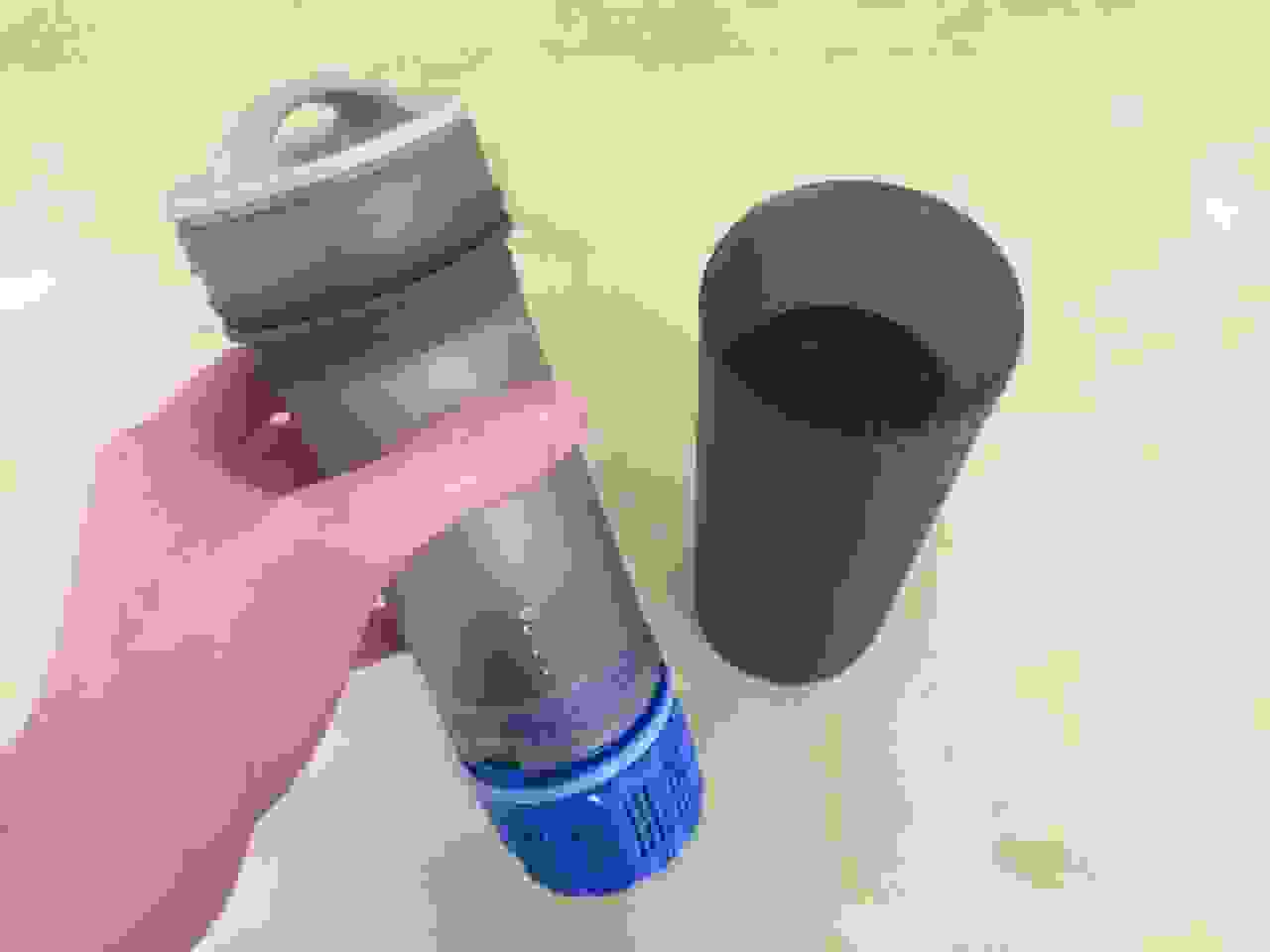
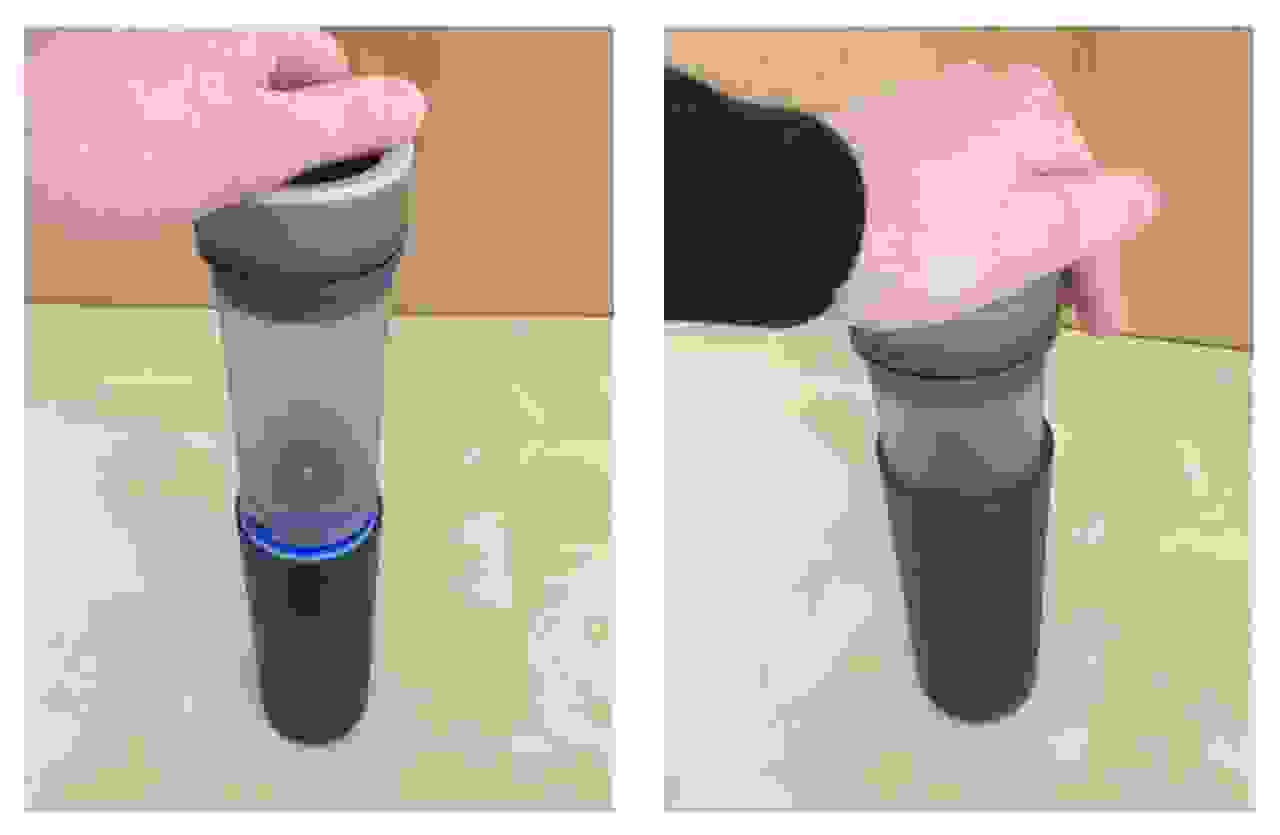
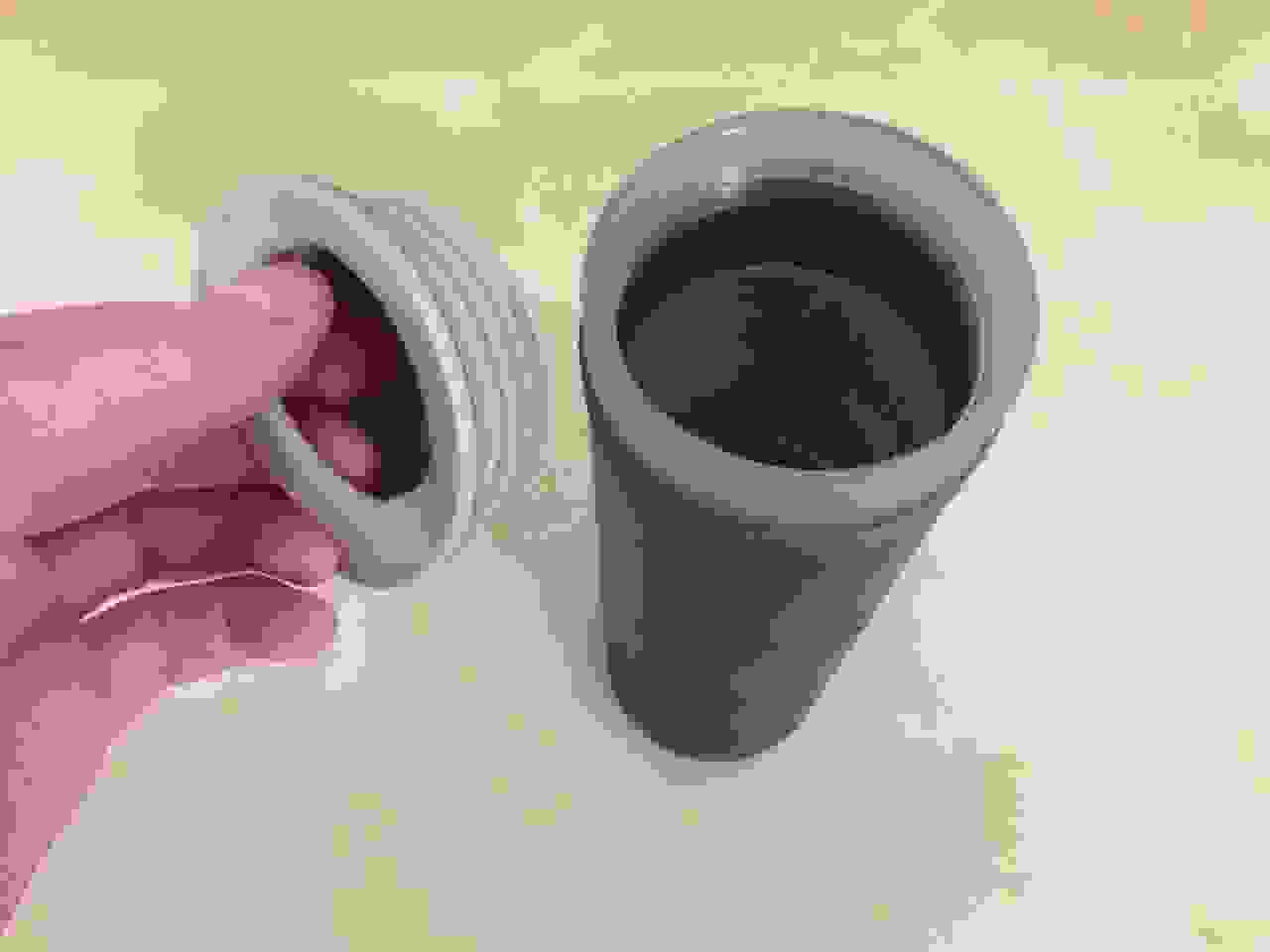



Check out Water Pure Technologies, they were one of 50 companies in NASA’S 2017 publication on Water Purification devices and systems… All of the systems they manufacture utilize the Nanos filtration media used in the Grayl
A good article & a very interesting comments thread! Thank you all for this! I love the tip of half-closing the lid during pushing down on the Grayl!
I’ve been using the Grayl UL as part of my ultralight hiking gear for a while & have filtered from sources ranging from tap water to brackish water at the coast and it is performing admirably.
A couple of comments & questions:
* A larger version of the Grayl would be amazing at some point in the future. Lots of UL folks are using 1l Nalgene widemouth bottles (because you can eat from them, too) – so if a future 1l Grayl would stay inside those dimensions in terms of width/height/diameter, that would be absolutely amazing.
* Are there already flip-top mouthpiece lids available for the Grayl UL? The screw-on lid is very sturdy & seals great, but for increased ease of use while hiking, a mouthpiece that could flip open from the lid would be very nice.
* There’s a very small chance of cross-contamination between the outer body after it has been submersed in an unclean water source and the inner’s silicone drinking lip: if the outer body still has drops of unclean water sticking to it after fetching water from a source and the Grayl gets turned upside-down shortly afterwards (think: being thrown into a bag or being kept in the user’s hand facing down), the potentially harmful drops of water may run onto the inner’s silicone lip and thus expose the user’s mouth to viruses / bacteria when drinking from the Grayl for the next time. It’s a small risk that can be avoided by drying the outer body on a piece of fabric / clothes after refilling.
* After pushing water through the filter into the inner body of the Grayl, some small residue of unclean water remains in the outer body / in between the outer and the inner body of the Grayl. It is a small leftover, something of about ~35ml. It does not pose an immediate danger to the user’s health since it cannot enter the inner body without going through the filter and the Grayl seals so well that it also can’t spill from the upper end of the outer body easily, but it does bother me and it will of course come out when removing the inner body before fetching more water from a source. Do you think it is recommendable to remove this leftover water after pushing the filter down? E.g. by removing the inner body with the lid still on, then pouring out the leftover water from the outer body and then re-inserting the inner?
Thanks again for this great blogpost!
Thanks for the tips. Always happy to have some feedback from someone who isn’t me. I’ve heard some hints about future product development, but they’re still secrets, and they might change anyway, but I can see a 1 liter version being quite useful, and a sippy lid would be especially great, for the reasons you describe. It would not only make it easier to drink, but also protect the mouthpiece from getting splashed or dirty.
As for the residual water left over, it’s not really a problem, since any water you push through the filter will be filtered anyway, and if you use it daily, it’s not like it would have a chance to spawn a bunch of harmful bacteria so rapidly, and then they get stuck in the filter anyway. I do empty it out before I store it though, and I occasionally dump it out and give it a rinse just to keep it clean from any buildup that’s in there.
First, I was wondering how you are supposed to minimize cross contamination. Because in order to take out the inner filter, you have to pull/twist it out (unless you are supposed to take it out with the cap still on) which would mean you have to use your grimy hands and touch the inside of the inner bottle which is supposed to only have clean water.
Second, how are we supposed to clean out the filter (i.e. if you need to clean out filter you used to clean dirty water). Do you just put clean water in the bottle and filter that ?
Thanks!!
So you end up just touching the outside of the inner bottle when you remove it, not the inside. Those rubbery rings near the top provide a nice grip, and you don’t run into too much trouble dirtying up any section where you’d be drinking from, if you’re careful. The only issue is right at the rim, where you’re drinking, so maybe once a week or so, I’ll use an alcohol swab to clean it off, then just let it air dry or dab it with a paper towel.
And yeah, cleaning out the inner cup requires clean water, but every time you use the filter, you’re pushing clean water into the inner cup, so if you just filter and pour it out a couple times, that’ll flush it out pretty well. Once I get home I might use soap and water, and you can do that on the road as well, as long as the water is clean to begin with.
Hi. I totally appreciate that you made this posting! I’m just starting my travels overseas with the grayle filter and was ready to abandon it because it leaked all of the water out upon pressure rather than forcing the water through the filter. While it makes perfect sense to loosen the lid to let the air out, I wouldn’t have thought it mattered since this information is no where to be found on the Grayle site. You’ve done them a big favor! And made this traveler very happy!
Thank you!
No problem. Little details like that are what I like to help with.